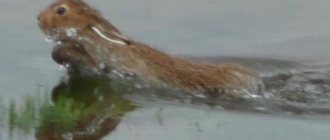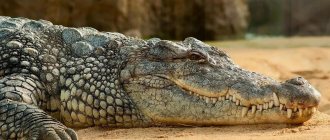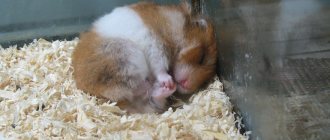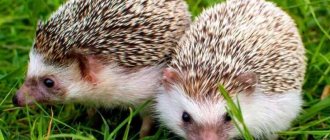Does a hedgehog hibernate? Depending on the time of year, the life activity of hedgehogs varies greatly. Moreover, differences in behavior are observed not only in natural conditions, but also in enclosures. With the onset of winter, hedgehogs hibernate for a long time.
Scientists around the world have long paid close attention to the similarity of the biological behavior of some mammals, as well as the hedgehog family. Most researchers of terrestrial fauna associate the long-term stay of animals in torpor when the temperature drops with an imperfect mechanism of thermal regulation.
Where do squirrels live in winter?
During the cold winter period, the squirrel moves mainly along the tops of trees, quite rarely descending to the ground. She spends the winter in her nest, plugging the entrance to the hollow in bad weather and severe frost. When waiting out bad weather conditions, the squirrel covers itself with its fluffy tail and curls up into a ball.
Interesting materials:
When to plant lavender seeds in open ground? When to plant carrots and beets for seeds? When to plant tomatoes with seeds? When to plant celery in open ground with seeds? When to plant watermelon seeds in the ground? When to plant watermelon seeds for seedlings? When to plant eggplant seeds for seedlings? When to plant broccoli seeds? When to plant Chernobrivtsev seeds? When to plant tree peony seeds?
How and when does a hedgehog hibernate?
With the arrival of spring, hedgehogs begin their active period. Conventionally, this time can be divided into 3 stages:
- awakening and searching for food;
- reproductive period (reproduction);
- finding a place and preparing for hibernation.
In the spring, as soon as the snow melts and the air warms up, the hedgehog comes out of hibernation and goes in search of food. Over the winter, he used up all his fat reserves. The prickly animal feeds on insects, beetles, and larvae. He can also come to the garden plot and eat berries and fallen fruits of fruit trees. In the absence of food, a hedgehog can even eat snakes or rodents. Hedgehogs are resistant to snake venom, so they have an advantage in a fight with a poisonous snake.
It should be noted that hedgehogs do not often eat snakes or mice. In nature, they are enemies and do not coexist in the same territory. Therefore, summer residents specifically try to lure the hedgehog to their plot. They attack snakes and mice extremely rarely, mainly due to the lack of other food.
After the hedgehog has refreshed itself, it looks for a partner to mate with. After mating, the hedgehog leaves the female, and the hedgehog takes care of the offspring.
In the autumn, before the onset of cold weather and hibernation, hedgehogs begin to actively gain weight. It is believed that an adult hedgehog must weigh at least 800 grams before hibernation, otherwise it may not survive the winter.
Hedgehogs do not store food for the winter. Instead, they actively store fat deposits. Thanks to the fat layer, the animal can hibernate for a long time, it helps to retain heat.
If a hedgehog fails to gain enough weight before the cold weather sets in, it may wake up hungry in the winter and die.
Why does a hedgehog hibernate in winter? It's simple, in winter there is no food for forest animals. In summer, the hedgehog's diet is quite varied. It consists of insects, larvae, berries, fruits and vegetables. In winter there is neither one nor the other. Therefore, the hedgehog stores subcutaneous fat and goes into hibernation.
The hedgehog's active period lasts from April to October. The hedgehog is in a state of hibernation from October to March.
Before a hedgehog goes into hibernation, it looks for shelter. Having climbed deeper, he curls up into a ball. At this time, his metabolism slows down and his heart rate decreases.
Hedgehogs are solitary by nature. They spend alone both the active period of life and the hibernation period.
Features of the behavior of hedgehogs
Hedgehogs are nocturnal. Often the entire large family goes hunting immediately after dark. When obtaining food, these animals use their excellent hearing and sensitive sense of smell. It is at night that all the sounds of nature are so clearly audible. And the hedgehog sensitively sniffs the odors, accurately determining the location of any beetle or worm in the ground at a depth of 3 cm. In order to dig up the soil, the hedgehog uses sharp claws. With a deft movement, he takes out the prey in a couple of seconds.
Hedgehogs get used to people quite easily;
they are trusting and kind creatures . It is worth contacting a person with a hedgehog several times, and the animal will happily accept food from human hands and even allow itself to be stroked without using defensive spines. Hedgehogs happily drink milk and feast on cat food. Hedgehogs' favorite human foods include:
- boiled potatoes;
- cheese;
- nuts and seeds;
- bread and pastries.
Mammal species
What hedgehogs do you know? To date, 23 species of creatures are known, which are included in 7 genera and 2 subfamilies. In addition to real hedgehogs, there are also rat hedgehogs, also called gymnurs. Do hedgehogs eat snakes? It depends on their variety.
The first subfamily includes the following species:
- The European (ordinary) hedgehog is the most common representative of the family. It is distinguished by its brown-brown color with dark crossbars. The areas where European hedgehogs live include parks, plains and woodlands of most European countries, Great Britain, north-west Russia and Kazakhstan.
- Long-eared hedgehog - it got its name because of its long ears, often reaching a length of 5 cm. What does an animal of this species look like? It is small in size (about 27 cm), sandy-gray in color. Weight is only 400 g. The long-eared hedgehog lives in the steppes, deserts and semi-deserts of Africa and Asia. It can also be found in the Russian Federation - in the territory from the Volga region to the Urals. What do animals eat in the desert? These can be a variety of lizards, beetles, ants, frogs, fruits, plant seeds and even small birds.
- The Eastern European hedgehog is very similar in appearance to its European relative. The mammal's habitat includes the countries of Central and Northern Europe, the Urals, Kazakhstan, and the Mediterranean islands. It is found in various areas - from personal plots to river valleys. What do hedgehogs of this species eat? They feed on large caterpillars, earthworms, woodlice, berries, mushrooms (champignons, russula, etc.) and acorns. This is the largest hedgehog known to date. Its weight can reach up to 1.2 kg.
- African dwarf hedgehog (white-bellied) - weight does not exceed 700 g. It is distinguished by a light brown or gray color. Hedgehogs are born with white needles, which then become slightly lighter, but their color always remains light. Animals live in some African countries (Sudan, Senegal, Ethiopia, etc.). What do African hedgehogs eat? Mainly insects, spiders, snails, scorpions. They hunt small snakes.
- The long-spined hedgehog (bald) lives in the countries of Central Asia and the Persian Gulf Islands. What do hedgehogs eat in confined spaces? It can feed on locusts, ground beetles, weevils, small rodents and reptiles. Does not disdain carrion, hunts snakes.
- The Ethiopian hedgehog resembles its other African relatives in appearance and is exceptionally voracious. What do hedgehogs eat? Animals eat everything that comes their way - insects, bird eggs, beetles, termites, frogs, snakes, etc.
- The Daurian hedgehog is a steppe representative of the family, living in the forest-steppes and steppes of Transbaikalia, Mongolia and northern China. Eats berries, toads, frogs, snakes, chicks and eggs. During a hunt, he is able to catch a large animal, for example, a pika or a hamster. The hedgehog's sharp teeth allow it to cope with any prey.
- Gymnura vulgaris is an exotic species, the largest in size and weight (up to 45 cm in length, 2 kg). It has a long (up to 30 cm) tail. The animal lives in the humid tropics of Southeast Asia. What does gymnura eat? Typically eats crustaceans, toads, fruits, fish and small animals.
- Gymnura minor - prefers to live in mountainous areas in southern Asia. Do gymnuras eat insects? These animals cannot boast of a rich diet, but they happily eat worms, beetles, and caterpillars.
Is it safe to interact with these animals?
As it turned out, hedgehogs evoke affection not only because of their appearance, but also because of their usefulness. They command respect from summer residents because they eat pests. Therefore, when a meeting between a hedgehog and a person occurs, people usually with the warmest feelings try to feed him and get to know him better. Before adding a hedgehog to your household, find out more about these animals. Being close to hedgehogs can also pose some danger:
Hedgehogs bite quite painfully and unpleasantly . They have real teeth. This animal is not domestic at all, but wild; you never know what infections it can introduce into your blood by biting. Therefore, if you decide to take a forest dweller in your hands, it is better to use thick gloves ; at least he will not bite them. As a consequence of the bite, an abscess may become inflamed in this place, which will be quite difficult to remove.
Encephalitis and Lyme disease can also come from this cute little animal. This happens because hedgehogs are inhabitants of forests and plantings, and ticks and fleas are most often found there. Because hedgehogs have spines on their backs, they scratch them off on themselves. They can parasitize for quite a long time, and the animal is already sick.
Take precautions. Regardless, take precautions when handling hedgehogs, especially when children touch or play with them. However, you should not shy away from these animals. It is also not necessary to drive them away when you see them on your farm. Try not to squeeze them and it’s better, of course, not to pick them up. So remember:
Hedgehogs already do a lot of useful things; you don’t have to squeeze them, because they are not pets at all, but inhabitants of the wild. However, if you decide to take care of a random guest, no one forbids you to feed him.
How to distinguish a hedgehog from a hedgehog?
Determining the sex of a hedgehog can be quite simple. It’s just that you won’t be able to pick up an animal, like a cat or a puppy, and turn it over. Because the back is protected by needles. Therefore, sex can be determined while the animal is eating.
Instructions:
- You need to pour food, and while the hedgehog is eating, gently run your finger over its stomach.
- If you come across a bump, it's a male. You came across his genitals.
- If you haven’t found anything other than fur and fluff, this is a female.
Is a hedgehog an animal, a mammal, a predator, an omnivore or not, which order does it belong to?
Hedgehogs belong to the order Insectivores and the family Hedgehogs . The fact is that hedgehogs actually prefer various fruits, leaves and carrion, and insects. This is precisely their benefit. Because a medium-sized hedgehog can eat 200 g of insects per night.
They are mammals. Indeed, after birth, the mother feeds her babies with milk. But there are those who live near cities, so they eat whatever they can find. This could be the remains of some animal food, meat, rotten fruit, trimmings. If you choose, they give preference to insects, as well as small rodents and mice. They are predators.
Hedgehog
The myth of the hedgehog
It is interesting and even a little sad to learn that our idea of a hedgehog carrying an apple or a mushroom on its needles is fundamentally wrong. These little animals never prick food on their needles; at most they can transfer leaves for their burrow in this way.
Now you have learned a lot of interesting things about hedgehogs, but even if you meet this animal in the forest or near your house and bring it home, remember that you have a great responsibility for the life of this small and defenseless animal. But don’t forget that the hedgehog sleeps in winter, so if you see that the animal weighs very little, this means that it has not gained enough fat reserves before entering a state of suspended animation, and there is a very high probability that your prickly neighbor may not survive the cold in the wild.
We invite the forest inhabitants to come to us
If you want these wild animals to visit your site at least occasionally, you can take some actions. Tip #1 - bait. If you attract a hedgehog with food, he will not forget it for a long time, because he is such a glutton. Some facts to note:
- hedgehogs are easily tamed;
- omnivorous;
- quickly get used to a person.
Of course, the first contact with a hedgehog may not be successful. Until the animals recognize your intentions, you will not be able to tame them. At first, they can behave quite aggressively - snort, puff, hiss and puff, and if possible, run away. But as soon as they understand that you do not wish them harm, they will change their anger to mercy.
Sources:
https://zoolog.guru/dikie-zhivotnye/gde-mozhet-zimovat-ezhik-spyachka-zhivotnyh-osobennosti-zimy-dlya-ezha.html https://www.kakprosto.ru/kak-863238-gde-i -kak-zimuyut-ezhiki https://liveposts.ru/articles/animals/gde-zimuyut-ezhiki
Description of the animal
The animal has a small size (length on average 15 cm, weight - from 300 to 800 g), an elongated muzzle with a well-defined snout, and beady black eyes. Forest hedgehogs have poor vision, but their mobile nose, studded with many vibrissae (whiskers), allows them to smell even the slightest smell of food. Poor eyesight is also compensated by excellent sensitive hearing.
The main distinctive feature that hedgehogs have in nature is the spines that densely cover the back, sides and forehead of the animals. The length of each needle does not exceed 2 cm, but due to their thickness they create reliable protection with which the hedgehog is able to cope with any enemy.
Under the needles and skin there is a layer of strong ring-shaped muscles that allow the animal to curl up into a ball when in danger. How many spines does a hedgehog have? Scientists have calculated that an adult creature, depending on its size, can have 5-6 thousand spines, while hedgehogs usually have no more than 3 thousand.
Needles, like human hair, are periodically renewed. They fall out once every 3 years and are replaced by new ones, which take about 12 months to grow.
Hedgehogs in the forest are predators, so they have strong teeth that are as sharp as a cat’s. Each mammal boasts 36 well-sharpened teeth that can fall out in old age. There are 20 of them on the upper jaw, and 16 on the lower jaw. But there are known species of hedgehogs that have 44 teeth, while the upper incisors are elongated and look like fangs.
The legs of hedgehogs are short, the hind legs are slightly longer than the front ones, and have 5 toes. The exception is the white-bellied species. In such animals, each limb ends in four fingers. Mammals use their elongated middle fingers to clear dirt and debris from their spines.
Hedgehogs have a variety of colors, but all of their tones are black, brown, brown, white or sand. Thus, brown can turn into lighter, and black into white, forming spots on the stomach, chest and paws.
Habitat
The hedgehog can be found in a wide variety of places, often its favorite habitats are the edge of the forest, thickets of bushes, clearings... Hedgehogs also often “settle” next to people’s homes. This common animal can live in Central and Western Europe, southern Scandinavia, Western Siberia, as well as Spain and Kazakhstan. In general, hedgehogs avoid solid coniferous tracts and vast swamps; other places where trees grow, even if it is a human-developed park, are quite a favorite place for them. Hedgehogs get along well next to humans, and are even his assistant in the fight against various kinds of rodents, snails and other not-so-pleasant “neighbors.”
Does he need to sleep?
In fact, no. Hedgehogs do not need to hibernate. But it has to. Hibernation itself is even dangerous for the animal, since it does not control what is happening. His hole could be flooded with water, and he simply wouldn’t have time to wake up. Also, the ambient temperature can drop sharply, causing him to simply freeze and die.
These, although prickly and unapproachable, are very cute animals in the warm season, great hard workers and hunters, and in the winter they are dormouse, waiting for the onset of spring in their burrows. Hedgehogs are very common in our latitudes, so almost all of us are familiar with these cute little animals.











